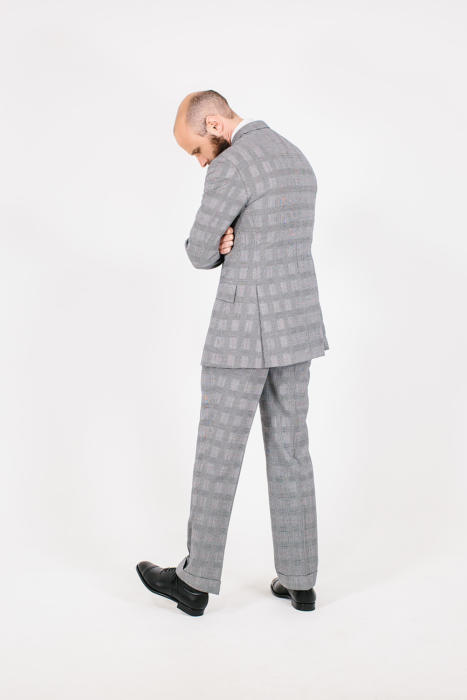
The reviews of bespoke suits I’ve written over the years haven’t always been the same.
Some included more on the experience (particularly when it was bad); some focused on the fit; others were more about style or make. Their length and depth also varied.
In order to produce a consistent, in-depth reference source, therefore, over the next few months I will be looking again at every suit I have had made by a major tailor.
Each will be re-photographed, in a studio with the same light, postures and angles.
I will comment on my experience, particularly in wearing it since I first received it, and the quality.
But the main focus will be the style: how the house cuts vary between each tailor and between each of the regional traditions. It is the aspect most readers ask about, and probably the one I have covered least in the past.
This first post will be used as an introduction and reference for the rest of the series. So here are some basic points on the methodology.
First, although some measurements will be taken and stated, there won’t be dozens of them. This is partly so that the pieces don’t become too numerical, and partly because measurements can sometimes be misleading.
For example, the shoulder width on a jacket depends both on how far that shoulder extends over the top of the arm, and on how far the collar is cut up on the neck. It varies at both ends. A smaller shoulder measurement doesn’t necessarily mean a narrower shoulder on the suit.
Second, while these posts will contain more style detail than anything covered in Permanent Style before, it is impossible to include everything.
We will select the points based on how important they are to the aesthetics and functionality of the suit, and on how much they vary between tailors.
So while we might mention a technical detail such as whether the jacket has a side body or not, we won’t go a level below that and start counting stitches per inch. It would be never ending.
Thirdly, the focus will be on the style of the jackets, rather than trousers or waistcoats.
Trouser measurements will be mentioned, but the jacket is where most of the variation between tailors lies. And in general trouser shape and waistcoat style are more at the discretion of the customer than shoulder width, for example.
Lastly, we will cover the tailors in regional batches – English, French, Neapolitan etc – in order to highlight the smaller differences between houses in each country, and avoid being blinded by the larger ones.
Fortunately, most of the time when I’ve commissioned suits over the past 10 years, I have gone for the house style.
Originally this was because I wanted to learn about the different houses, and was interested in their respective cuts.
But as the years went on, it was also because I knew Permanent Style readers would like to see the house styles. It was about the blog, not just about me.
So the pieces we show will be pretty representative. Each piece will also be discussed with the tailor, to check this is the case.
Some variations between the suits are inevitable. For example, there are one or two where I only have a double-breasted jacket, not a single.
But it will still be possible to compare most points, such as the shoulder padding and width, the sleevehead, the sleeve, the breast pocket, darts and so on.
Above is a diagram that sets out some basic tailoring terms to be referenced in the pieces. It seems sensible to include it here, rather than repeat it in every article.
A: Sleevehead
B: Gorge
C: Outbreast pocket
D: Buttoning point
E: Skirt (the line, and amount of width, through the hips)
F: Opening of the quarters
And then below are some explanations of the measurements themselves and where they’re taken from. Any questions, please shout.
A – Shoulder width
The length of the shoulder seam from where it meets the collar to where it meets the top of the sleeve (the sleevehead).
B – Shoulder padding
How thick the padding of the shoulder is, and in some cases what it is made from.
C – Sleevehead
The top of the sleeve. Whether it has any ‘roping’ in it to raise it up, or it runs smoothly from the shoulder into the arm.
D – Sleeve
How wide the sleeve is, and whether it narrows towards the bottom (the cuff).
E – Lapel
The horizontal width of the lapel at its widest point (the lapel point on a notch lapel, the peak on a peak lapel).
F – Gorge height
The distance from the point of the lapel to the shoulder seam.
G – Drape
How much extra space, and therefore cloth, is kept in the chest and back.
H – Outbreast pocket height
The distance from the bottom of the chest pocket’s welt to the shoulder seam.
I – Buttoning point
The fastened button on the jacket. Its distance from the shoulder seam.
J – Waist suppression
How closely the jacket is cut into the waist of the wearer, at the sides.
K – Back seam
The line of the seam down the back of the jacket. How close it is cut into the waist of the wearer.
L – Quarters
The front of the jacket below the waist button. How open they are, how curved the opening is, and where it starts.
M – Length
The length of the back seam of the jacket.
N – Vent height
Vents are the cuts in the bottom of the back of the jacket. How high they are.
O – Trouser circumference at knee
The distance right around the trouser (not its width) at the knee.
P – Trouser circumference at cuff
The distance right around the trouser (not its width) at the bottom.


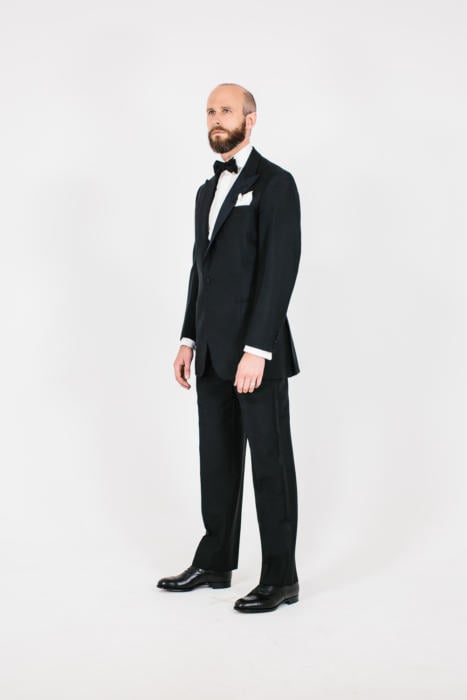
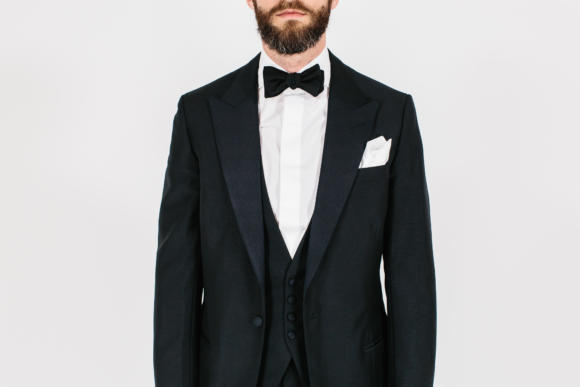
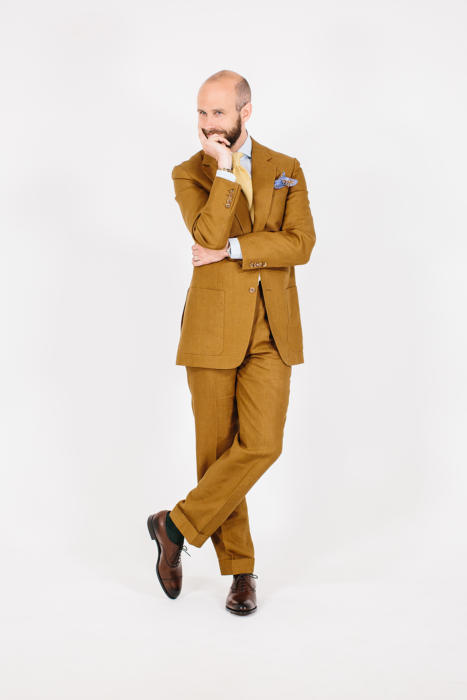
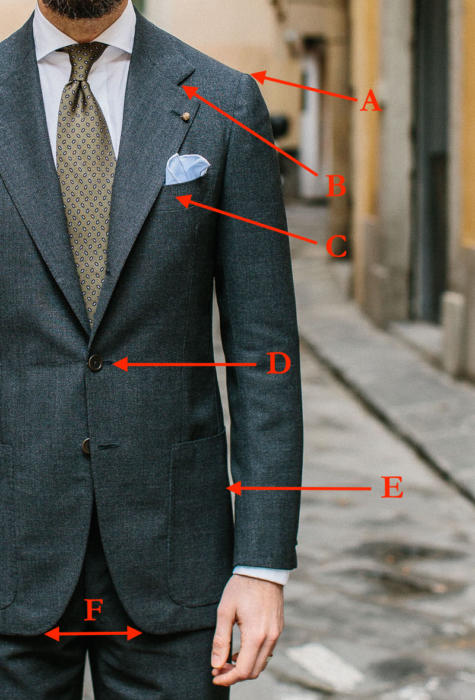
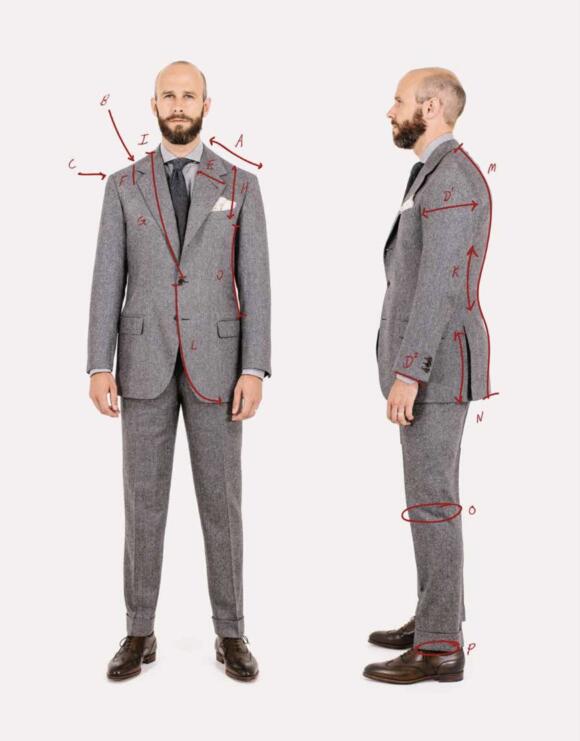


























Great idea Simon. Love it!
Might be an idea to include some RTW and MTM to highlight where the differences lie.
Particularly considering this is an extremely useful benchmarking and referencing exercise .
Thanks Robin, interesting point. I think that might make for too large a range of differences to focus on, and of course RTW and MTM change so much more frequently in terms of style. But i’ll look at it
Really great idea! Maybe you could add the lapel width and if the lapel is pressed or rolled…
Lapel width will definitely be included. Pressing of the lapel is harder to be precise about, but I’ll try to mention it if it varies significantly
I don’t even know what a lapel being pressed or rolled is! Maybe keep it simple (and avoid details like that) to keep it accessible
Hello Simon, longtime reader, first-time commenter here. Just wanted you to know I think this is an inspired idea and I’ll be very much looking forward to this series! Thank you so much for the work you do.
Great idea, Simon, and a nice recap of what has happened since Day 1. Must be an exciting trip down Memory Lane for yourself, going back to all the tailors again. No doubt it will turn out an invaluable source of reference for all of us out there.
Since you are confirming house cuts with the tailors anyway could you please also confirm current entry level prices? For many this will be very relevant too.
Good point Oskar, yes I will
Love the idea! I’m excited to see the pieces again in better angles and lighting, to be able to compare them better and to read more of your thoughts on them. Maybe these could get their own list on the site, like the cloth guide?
Absolutely
Simon,
I think that this will be a wonderful series! And I hope that it is pleasurable for you to return to previous suits and the associated memories.
One request is to please have at least one front-on shot of the whole jacket without your hands in your pockets *cough* Camps *cough* (I am always guilty of this and know how tough it is!)
Looking forward to it!
Don’t worry Hugh, we’ll certainly have that!
Brilliant, original, and very generous initiative.
Thank you for this, Simon, I look forward to seeing this very useful series of posts evolve.
Sounds very useful indeed.
Will this be at the expense of other more “BAU” postings?
Not really – the posts will only be every 2 or 3 week, but as with the Guide to Cloth series, will build up into something really nice
Great idea. May I ask you who made the suit on a top of this post?
Henry Poole
Reviews are useful but can also be meaningless unless benchmarked and referenced for comparison.
This new venture will certainly put things into a better perspective .
Thanks. Do let me know in comments on those pieces when more context or benchmarking is needed
I applaud this massive undertaking, it will be very valuable and interesting for us readers.
A really great idea. Thank you,. Simon.
Looking forward to follow this great idea. I´m sure this will turn out to include some very valuable information and source of reference for both new and old bespoke customers.
“opening of the quarters”
…..Uh, should they?
Of course only in double – breasted should there be a complete overlap.
However, IS there an aesthetically arguable way to describe the need for this. and or how much?
Simon, I think you have truly outdone yourself in deconstructing the jacket to point out a style consideration for it….amazing….I have to admit, it is something that is out there front and centre, and yet I can’t say I have ever given it any consideration….nor has it ever been pointed out…
Is it something you noticed yourself, or is it something that you picked up from one of the many excellent tailors you have met and dealt with?
It’s a fairly important part of the style and cut, ANM.
If you consider that an ‘X’ shape that begins with the width of the shoulder and sleevehead, runs through the waist, and then ends at the bottom of the quarter, is an important part of the way a jacket can flatter you, then this opening is key. As is the amount of fullness in the bottom, or skirt, of the jacket.
In general, southern Italian tailors and ones aiming for a more ‘modern’ style tend to open these quarters more. Conservative tailors do so less, and think opening it up shows too much of the crotch, and perhaps the shirt above the waistband of the trouser too.
And… just as important as the opening is the shape of those quarters – the front edge below the waist button. An English tailor will have this line much straighter, a Florentine or Neapolitan more curved.
It’s a good example of the kind of thing an English tailor doesn’t change when they make a soft ‘unstructured’ jacket, and means that the jacket below the shoulders looks exactly the same as a normal English jacket, and nothing like a Neapolitan
Good afternoon Simon, I hope you’re doing well, just to let you know that I’ll be very much looking forward to this new experiences!! Keep with a great work!! Regards
Simon,
I am looking forward to it.
Great idea! This is exactly why I read PS daily and have been for the past nine years.
Nice, thanks Brett
Simon, I think that informations about amount of hand work (In hours per jacket)) and average price tags also will be very useful))
Thanks for sharing your experiences and knowledge Simon. You are a great resource and I appreciate your hard work and passion.
It’s really this appreciation for retrospective that has set you apart from other men’s style journalists.
Will you cover absolutely all of your suits, or just the ones that have seen the most constant use? Whichever the case, I – like every reader, surely – look forward to this most welcome addition to PS.
We will do the biggest houses, and perhaps most distinct styles, to start with. Should still number 30 or so
Will you include your first from GB?
Thanks,
S
Probably not, no
Why not include something from GB? It’s where you (and this blog) started out and from what I can see the fit of your GB suits are no worse than the rest of your structured English suits.
I wonder if it is a bit of snobbery in this, now that you have established yourself as a top of the market blogger? For many of your readers I think it would be very interesting to see how GB would compare to the rest.
Thanks,
S
The fit is certainly not worse, but the make is at a lower level. I don’t think it would be fair to compare it to all the others really. I will consider it though.
I’ll add my vote to wanting to see the GB suits covered. Of course its make is at a a lower level and not directly comparable to the rest, but I think that’s partly why it is of interest to me: what are the compromises when going down to that level, and how do they actually play out in terms of real life fit/look/style/durability?
Overall very much looking forward to this series as I start to get close to commissioning my first bespoke jacket or suit.
It still boggles me how many you’ve tried over the years. That’s gonna be lot of good reads. Cheers.
Simon,
This is an excellent idea.
Would you consider mentioning your experience with the fabric and weight?, even though it’s not overtly style-related, I think it would be good information. For example, how you’ve mentioned you prefer an Irish linen to and Italian one, despite the heavier weight – it would be nice to hear about the performance of the fabric too, in addition to the performance of the suit in regards to versatility, etc.
Cheers
Simon,
will you be doing a review of Tom Sweeney in this series even though you had a jacket and trousers made rather than a suit? as i would love to hear your thoughts since your last review.
I will review things where I just had a jacket, but not sure about Thom Sweeney. I’ll see
Simon, when I was at the same university as yours, it was simple to nip across from Exeter College to have drinks with my friends at Trinity. However it is not so easy to nip down to Savile Row for those of us who live in the provinces and I wonder whether, as an adjunct to these detailed style reviews, you could include an article with some general pointers as to what to look for when a suit “looks good“ on someone. You will appreciate that many of us seek out skilled local tailors and go on recommendation and that recommendation is often triggered by a friend who walks Into a room with a suit that just has ‘the fit’ – just what is it that is most likely to make the garment stand out expressed not in detail but in general terms: I had an uncle who was a tailor and he would rail at the newscasters on television with some very helpful pointers like ‘this chap’s collar should not be standing up away from the neck even when the wearer is sitting down!’
We have written about that a fair bit over the years, and you’re right it’s nice because it applies to any level of suit. The points tend to be in different posts though, rather than gathered together in one.
Try this post to start with and the Suit Style series.
Simon, fantastic advice all round. I’m posting this here as I haven’t found a better post to pop this question on to. What is the best alternative to a wool suit? As someone who recently started to phase out any products made form animals I suddenly realised that I am due for new suits next season and if I’m not mistaken the excellent quality Austrian merino wool I usually buy suits in comes form an animal. Can cotton make the cut?
Cotton or linen will be your best options. Bear in mind with wool though that it’s something sheep naturally shed every year. Very different to meat for example
Bamboo
Great idea Simon! Please also take note that some house cut may have modified since the time you commission the suit with the tailor. In that case, perhaps you may enlighten us with the updates on the changes.
Thanks Felix. I actually checked with Richard before publication that everything I had was house style and nothing had changed, so that should be fine hopefully
Hi Simon,
I am looking to invest in a great quality navy suit. I am suit unsure on two things.
Cloth:
I have always been told H.Lesser is possibly the best you can get in terms of a mid weight navy. Do you agree?
Style:
I am torn between patch pockets or jetts. What do you reccomend.
Hi Rhys
Lessers isn’t necessarily what it used to be, and even then it may be you wouldn’t notice the difference. I’d recommend picking on weight more, from any decent mill.
On pockets, for a dark smart suit I wouldn’t have patch pockets. Go for jets, or even flaps since they should be able to be folded inside and look just like jetted pockets ( and you have the option of flaps if it turns out you prefer that style)
Hi Simon,
Could you reccomend a quality mill and also what weight cloth would you reccomend for an all year suit?
Have you looked at our mills and merchants series? Don’t focus too much on mills….
And for fabrics, look at the Guide to Cloth, probably worsted suitings for your question.
Simon, is it unreasonable with a bespoke jacket to expect the pattern on the back of the collar to line-up with the pattern on the back of the jacket?
No, you should in general be able to control one point in the back and make it match, and that would usually be the collar
Hi Simon,
Could I just ask who made the grey suit, towards the end of the post, with the measurement annotations?
Many thanks
Sartoria Ciardi. There’s a full review on the site – have a quick search
For shoulder width, maybe measuring from sleevehead to sleevehead would have allowed for better comparisons (avoiding the distorsion from where the collar is cut up the neck). I just mention it because to me shoulder width changes the cut the most.
It’s a good point. Generally I’ve found the distortion is quite small (eg even though A&S cuts a small back neck, their shoulder is still one of the widest) but going across the whole shoulder might have been more accurate
Simon – a slightly odd question, just trying to gauge the perspective of these images: when the shots for the tailor styles series are taken what position is the photographer in? Crouched down on haunches?
The camera is on a tripod, around navel height
Hi Simon – a bit confused as to one measurement in this fantastic series. When you measure the buttoning point from the shoulder seam, do you measure straight from the button up to where the collar is attached or do you just measure from the seam to the button line? Also, annoying to ask, but do you take into account jackets with backwards facing seams vs just straight across? Surely that would affect this measurement too if so.
Secondly, does jacket length include the collar or just the centre back seam measurement?
Thanks so much.
No worries Leo.
I measure from the waist button to the shoulder point – where the shoulder seam meets the collar.
I don’t take into account backward-angled shoulder seams, no, so that does create some small variation.
Jacket length is just the centre back, without the collar.
HI Simon
I have been a passionate follower of your blog for a while and I always enjoyed reading your detailed content.
I have question.
My brother is getting married next summer and we are looking for a tailor in the area of London.
He is aiming for a suit of around 3000£ and after reading your blogs, i think Whitcomb & Shaftesbury is our first preference. Mainly due to its consistency of delivery good quality and value.
Do you think this is a good choice or would you recommend another tailor?
kind regards
Hi Oliver,
If that’s the kind of style and cut you’re after, I think it would be a very good choice, yes.
Hi Simon,
I have been a long time fan of your instagram (where i first discovered you) and now your website. I find the guides you’ve created incredibly helpful and makes ordering bespoke suits and shirts much less daunting. I had a quick question for you around bespoke tailors in the city of Turin. I know in Italy everyone focuses on Naples and Milan as the style capitals of the Boot but Turin has seen some incredibly stylish men over the years (Agenelli family for example).
Do you have any recommendations for bespoke tailors and shirt makers in the city?
Thanks!
I’m afraid I don’t Lamberto, sorry. I have visited, and I remember there being one or two nice menswear shops. But I don’t know any tailors.
I’m not sure if Agnelli used any local tailors there, but obviously he used others in Milan.
Hi Simon
What do you mean when you say shoulder width? I have again read through several pieces in this series but can’t find the explanation. It can’t be the overall shoulder width of the jacket as I would expect that to be around 18 inches or so rather than 6-7 inches (or less on some styles) which you have mentioned.
Many thanks.
Sure – it’s the width along the shoulder seam, from collar melton to sleevehead.
OK, thanks – so the width from where the collar sits on the shoulder line and the sleeve head?
Is there a reason for using this approach rather than the full width between the sleeve heads, as any resulting effect will be on the overall shoulder width?
No, in retrospect we probably should have used that measurement, it was just that measuring the shoulder seam itself felt more precise
Great series, Simon! I learned so much!
The nerd in me couldn’t resist doing some analysis on your measurements data. I put together this chart to visualize how similar/different each style is. The axes are just statistical measurements of similarity, so they don’t mean much on their own, but overall we can look at how close different points are on the chart to understand how similar those tailors’ styles are to each other.
What’s the use of this beyond the great analysis you’ve already provided? There probably isn’t any, but I thought it was interesting nonetheless as cold numbers can sometimes reveal insights that escape the human eye!
Blimey! Thank you Theo. New series on coats coming soon so be interesting to see what you make of those, though they will be harder to analyse I think
Hi Simon, I live in Australia and planning a trip to Europe this year, looking to do some suits and jackets at Naples. I’m wondering how long it normally takes to for them to finish a suit. Is it possible to get it done in half Month? And also Panico and solito are my priority, do you have the price guides for them right now? Thanks
I don’t have current prices I’m afraid, no. Also Panico is largely retired now.
I don’t think any will be able to finish a suit in that time I’m afraid, it’s normally weeks between fittings. Some have offered a special service in the past to cater to visitors, but it means clearing their whole workshop of other work, so most don’t do it
I would have liked to have seen an explanatory intro post to the tailoring style series specifically focused on the measurements which are in each of the 25 style breakdowns. Take gorge height for instance. An arrowed diagram showing the points of measurements from point to point and maybe a brief explanation would be most helpful. I still find that slightly confusing. Buttoning point is another example. Drape and suppression circled. Outbrest pocket height and the other measurements as outlined in each style breakdown.
I think it would be of immense help , not only for the style breakdowns to date but any subsequent new commissions.
Thanks – these are described in the articles, but you’re right, there is no central diagram. I assume you saw the diagram in the intro piece that at least showed the points on the jacket we are talking about?
Let me know if anything isn’t clear in the meantime and I can explain
I totally agree with )¥.
In the book “Bespoke Style”, if I’m correct, there are very detailed explanations.
A detailed precursor to the style series would be a very interesting and informative intro to the tailoring style series.
Very good point, there are, I’d forgotten that! OK, I’ve now added those to the bottom of this piece – let me know if any of them don’t make sense?
Thanks
I was reading through the “All Threads” and came upon this thread.
This diagram is a great addition and will make the Style Breakdowns much more informative and helpful.
Super stuff!!
Oh good, nice to know Lindsay